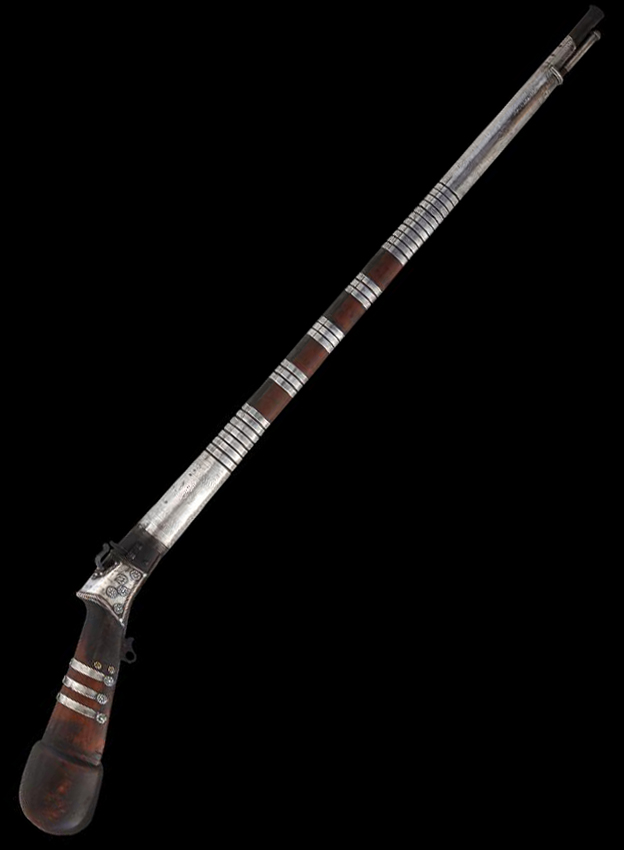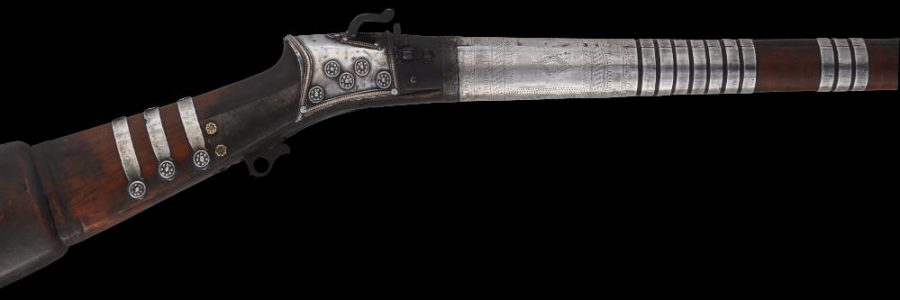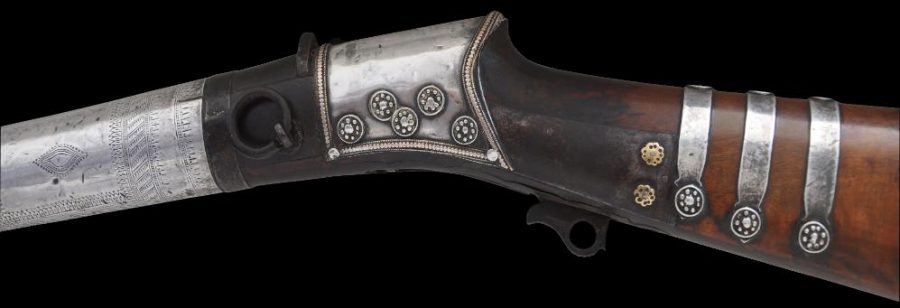Enquiry about object: 1335
Rare Matchlock Gun with Gold & Silver Mounts
Coorg, South India 18th century
length: 142cm
Provenance
UK art market
This eighteenth century matchlock gun from the Coorg people of Malabar, South India is extensively silver mounted with gold trim over iron and finely grained wood. The barrel is sheathed in silver bands – 27 in all. The fore-end and muzzle are each covered in sheet silver finely chased and engraved with scrolling foliage and floral motifs within geometric borders. The stock also is decorated with silver bands – these are secured with silver rosettes. Other rosettes are in gold. The trigger case is also sheafed in silver secured by a multitude of silver rosettes and with a rose-gold rope-twist. The silver decoration about the underside of the muzzle is particularly attractive and fine with Islamic-inspired foliage patterns of a type seen from the Middle East to India to the Malay Peninsula.
The end of the wooden ramrod is sheathed in silver and has a spherical silver finial, beneath which there is a rope-twist border in rose gold.
The butt is monstrously swollen and rounded – typical of Coorg guns. This feature was included to help absorb the recoil shock, but also would have been useful as a club.
The barrel is slightly octagonal.
The form of the typical Coorg gun was heavily influenced by guns from Arabia – groups of Arabs settled along the Malabar coast over the centuries as a consequence of the dhow trade with Arabia – trade that had occurred since at least 2000BC. The influx of Arabs brought Arabian weapons to India’s south over the centuries (and to Sri Lanka too where, to this day, there is a large Arab-descended Muslim population). Many Arabs particularly the Hadrami of Southern Arabia (in what today is Yemen) served as mercenaries. In the sub-continent, Hadrami mercenaries were most associated with the army of the Nizam of Hyderabad. Such interaction resulted in hybrid Indo-Arabian weapons – often weapons of Arab form but with localised, Indian decoration.
Elgood (1995, p. 184) reproduces a watercolour of around 1850 held in the India Office Library, London, of a Coorg man dressed in traditional costume, holding a distinctive Coorg gun, not unlike the example here.
Quality Coorg weapons are not often encountered on the market. One reason is because in response to an outbreak of violence near Malappuram in 1884, the local British administration confiscated all arms, seizing 17,295 weapons of which 7,503 were guns. The Madras Museum selected a few of the better examples and the remainder were dumped into the sea (Elgood, 1995, p. 185).
Overall, this example is relatively rare and very attractive – the patina of each of the main elements: the silver mounts, the iron working parts and the wood supports is excellent and lustrous.
References
Elgood, R., Firearms of the Islamic World: In the Tareq Rajab Museum, Kuwait, IB Taurus Publishers, 1995.
Stone, G.C., A Glossary of the Construction, Decoration and Use of Arms and Armor in all Countries and in all Times, first published in 1934, Jack Brussel, 1961.














